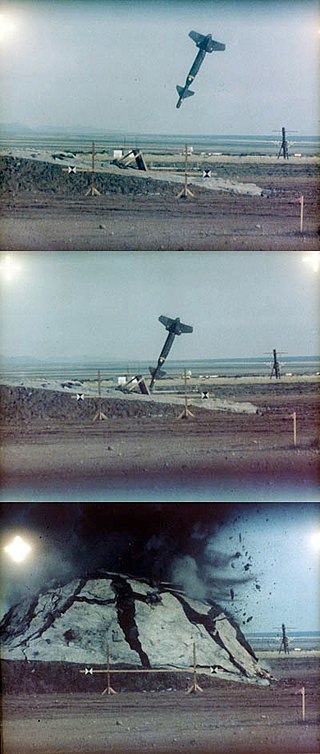
The Dassault Mirage III is a family of single/dual-seat, single-engine, fighter aircraft developed and manufactured by French aircraft company Dassault Aviation. It was the first Western European combat aircraft to exceed Mach 2 in horizontal flight, a feat which was achieved on 24 October 1958.
Semi-automatic command to line of sight (SACLOS) is a method of missile command guidance. In SACLOS, the operator must continually point a sighting device at the target while the missile is in flight. Electronics in the sighting device and/or the missile then guide it to the target.

The Exocet is a French-built anti-ship missile whose various versions can be launched from surface vessels, submarines, helicopters and fixed-wing aircraft.

Missile guidance refers to a variety of methods of guiding a missile or a guided bomb to its intended target. The missile's target accuracy is a critical factor for its effectiveness. Guidance systems improve missile accuracy by improving its Probability of Guidance (Pg).

The Atlas Cheetah is a South African fighter aircraft designed and produced by the aviation company Atlas Aircraft Corporation. It was developed at the behest of, and principally operated by, the South African Air Force (SAAF).

The Dassault Mirage 5 is a French supersonic attack aircraft designed by Dassault Aviation during the 1960s and manufactured in France and a number of other countries. It was derived from Dassault's popular Mirage III fighter and spawned several variants of its own, including the IAI Kfir. In Pakistan's service, the Mirage 5s are modified and are capable of nuclear weapons delivery.

The Hughes AIM-4 Falcon was the first operational guided air-to-air missile of the United States Air Force. Development began in 1946; the weapon was first tested in 1949. The missile entered service with the USAF in 1956.

The R.550 Magic is a short-range air-to-air missile designed in 1965 by French company Matra to compete with the American AIM-9 Sidewinder, and it was made backwards compatible with the Sidewinder launch hardware.
Command guidance is a type of missile guidance in which a ground station or aircraft relay signals to a guided missile via radio control or through a wire connecting the missile to the launcher and tell the missile where to steer to intercept its target. This control may also command the missile to detonate, even if the missile has a fuze.

The AGM-12 Bullpup is a short-range air-to-ground missile developed by Martin Marietta for the US Navy. It is among the earliest precision guided air-to-ground weapons and the first to be mass produced. It first saw operational use in 1959 on the A-4 Skyhawk, but soon found use on the A-6 Intruder, F-100 Super Sabre, F-105 Thunderchief, F-4 Phantom II, F-8 Crusader, and P-3 Orion in both Navy and US Air Force service, as well as NATO allies. The weapon was guided manually via a small joystick in the aircraft cockpit, which presented a number of problems and its ultimate accuracy was on the order of 10 metres (33 ft), greater than desired. In the 1960s it was increasingly supplanted by fully automatic weapons like the AGM-62 Walleye and AGM-65 Maverick.

The SS.11 is a French manual command to line of sight wire-guided anti-tank missile manufactured by Nord Aviation. It is also available in the air-to-ground version, AS.11, which featured a stabilized sighting system. The AS.11 was also known as the AGM-22 in American service. It is among the earliest guided anti-tank missiles, entering service with the French Army in 1956 and remaining in service into the 1980s. It also formed the basis for the larger and longer-ranged SS.12/AS.12 series.

The AGM-130 was an air-to-ground guided missile developed by the United States of America. Developed in 1984, it is effectively a rocket-boosted version of the GBU-15 bomb. It first entered operational service on 11 January 1999, and was retired in 2013. 502 were produced.

A guided bomb is a precision-guided munition designed to achieve a smaller circular error probable (CEP).
The Kh-29 is a Soviet air-to-surface missile with a range of 10–30 km. It has a large warhead of 320 kg, has a choice of laser, infrared, active radar or TV guidance, and is typically carried by tactical aircraft such as the Su-24, Su-30, MiG-29K as well as the Su-25, giving these aircraft an expanded standoff capability.

The AS-20 was a French air-to-surface missile developed during the late 1950s. It was similar to the U.S. AGM-12 Bullpup missile.

The Matra R.530 is a French medium to short range air-to-air missile. It was available in infrared homing and semi active radar homing as the main armament of the Mirage III which was able to carry a single missile in the centerline, the Mirage F1, which carried two under the wings, and the F-8 Crusader, also carrying two on the sides of the fuselage in French Navy service.

The AIM-9 Sidewinder is a short-range air-to-air missile. Entering service with the United States Navy in 1956 and the Air Force in 1964, the AIM-9 is one of the oldest, cheapest, and most successful air-to-air missiles. Its latest variants remain standard equipment in most Western-aligned air forces. The Soviet K-13, a reverse-engineered copy of the AIM-9B, was also widely adopted.

A precision-guided munition is a guided munition intended to precisely hit a specific target, to minimize collateral damage and increase lethality against intended targets. During the First Gulf War guided munitions accounted for only 9% of weapons fired, but accounted for 75% of all successful hits. Despite guided weapons generally being used on more difficult targets, they were still 35 times more likely to destroy their targets per weapon dropped.

The AA.20 was a French air-to-air missile, developed by Nord Aviation, and was one of the first of such missiles adopted into service in Western Europe. Production began at Chatillon, France in 1956. Approximately 6,000 missiles of the type were produced, remaining in service until 1960.


















